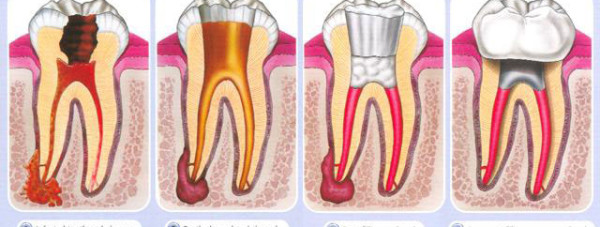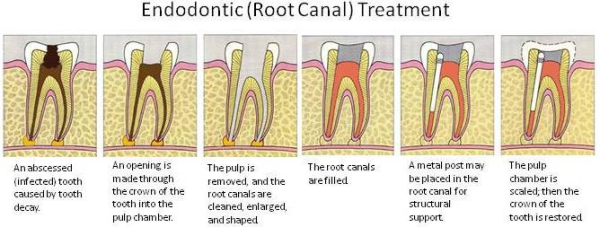R = Root , C = Canal , T = Treatment
RCT is a Endodontic treatment
The word “endodontic” is composed of two Greek words, “endo” meaning “inside,” and “odont” meaning “tooth.” Endodontics is that branch of dentistry that deals with the diagnosis, prevention, and treatment of diseases that arise from the soft tissues (the dental pulp) inside the tooth.
![]() The dental pulp is a soft tissue that resides inside the tooth within the root canal space. This pulpal tissue is composed mainly of blood vessels, nerve fibers, and connective tissue, similar to tissues elsewhere in the body.
The dental pulp is a soft tissue that resides inside the tooth within the root canal space. This pulpal tissue is composed mainly of blood vessels, nerve fibers, and connective tissue, similar to tissues elsewhere in the body.
When I need RCT ?
If the pulpal tissue is injured and becomes irreversibly inflamed (Pulpits ) or infected, the tooth will need root canal treatment if it is to be saved. If left untreated, infection from the tooth can spread into the bone and surrounding soft tissues, causing pain and/or swelling.
Pulpit is an inflammation of the neurovascular bundle of the tooth (pulp). The most common cause of it is a untreated caries – caries first affects the outer part of the tooth, then gradually penetrating deeper and deeper into the tooth reaches the inner part, where the inflammation begins. The best way to avoid this is to timely treatment of dental caries.
Symptoms pulpit:
Common signs and symptoms that indicate root canal treatment may be necessary include lingering sensitivity to hot and/or cold liquids, sensitivity to sweets, pain with biting pressure, spontaneous pain, throbbing pain, swelling and tenderness of the gums or jaw, or discoloration of a tooth. Endodontic disease also may develop without causing any symptoms.
Once accessed into the pulp bacteria become a source of constantly existing infection in your organism and may cause various complications as far as tooth vessel system serves an inlet for the infection into the several important tissues.
If you have these symptoms are present treatment is best not to delay in the “back burner.”.Contact SMILE LINE as soon as possible.
What will be done ?
During the root canal treatment procedure, the dentist removes the inflamed or infected pulpal tissue, carefully cleans, disinfects, and shapes the root canal space inside the tooth, and then fills and seals this space. It may take one or more appointments to complete the procedure. A protective restoration should be placed after root canal treatment has been completed in order to restore the tooth to function and help prevent tooth fracture.


